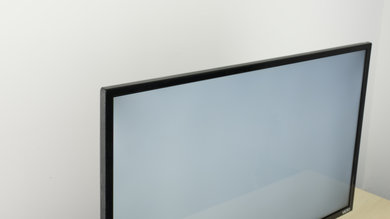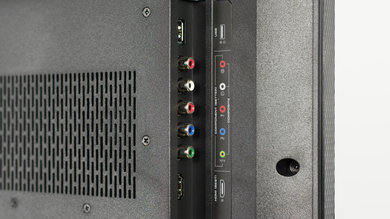Our Verdict
Subpar TV overall. The Vizio D Series 1080p 2017's redeeming qualities are far and few between. While its wide viewing angle adds flexibility, its poor picture quality makes it difficult to enjoy.
- Wide viewing angle
- Poor picture quality
- Low brightness
- Mediocre handling of motion
Bad TV for watching movies in a dark room. Its poor contrast and exceptionally uneven blacks cause distracting clouding in letterboxes and a dull looking image with blacks that often look grey. It also lacks a local dimming feature to alleviate some of these issues. It's also limited by its lower 1080p resolution.
Average TV for watching TV shows in a brighter environment. Its wide viewing angle makes it easy to place the TV in an abnormal environment like a kitchen where you might not view it from directly in front. However, its low brightness can't neutralize reflections and its smart features are a bit out of date.
Passable TV for watching sports. The D Series 2017's handling of motion is acceptable, and it can display the uniform colors of sports fields without major issues with blotchiness. Unfortunately, it isn't the best at handling the 720p resolution used with most sports broadcasts, and its low brightness can cause issues while watching daytime games.
Passable TV for playing video games. The D Series has a low input lag causing no major issues with responsiveness, and its motion blur performance is also decent. Unfortunately, its poor picture quality can make more graphics-oriented games look a bit dull.
HDR is not supported.
HDR is not supported.
Mediocre TV to use as a PC monitor. Its wide viewing angle makes it usable from a closer sitting position, but its lower resolution and lack of 4:4:4 support makes it less usable in a more productive setting.
Changelog
- Updated Mar 12, 2018: Converted to Test Bench 1.2.
- Updated Jan 09, 2018: Review published.
- Updated Jan 07, 2018: Our testers have started testing this product.
- Updated Oct 16, 2017: We've purchased the product and are waiting for it to arrive in our lab.
Check Price
Differences Between Sizes And Variants
The Vizio D Series 1080p 2017 TV has a few variants. The one we bought is the 32" with SKU D32f-E1. The smaller 24" variant uses a lower 768p resolution than the larger models. Some other differences can be found depending on sizes as illustrated in the table below. Our review is not valid for the 4k UHD variations of the Vizio D Series 2017.
If someone comes across a different type of panel or if their Vizio D Series 1080p 2017 doesn't correspond to our review, let us know and we will update the review.
Update 01/24/2018: The 50" model (D50f-E1) likely uses a VA panel, as explained in this Q&A. We expect it to score better overall than the IPS panel D32f-E1 we reviewed, due to having a much better contrast ratio and black uniformity; although its viewing angle will be worse, similar to last year's D50-D1.
| Size | Model | Resolution | Effective Refresh Rate | Real Refresh Rate | HDMI # |
| 24" | D24h-E1 | 768p | 60 Hz | 60 Hz | 1 |
| 32" | D32f-E1 | 1080p | 60 Hz | 60 Hz | 2 |
| 39" | D39f-E1 | 1080p | 120 Hz | 60 Hz | 2 |
| 40" | D40f-E1 | 1080p | 120 Hz | 60 Hz | 2 |
| 43" | D43f-E1 | 1080p | 120 Hz | 60 Hz | 2 |
| 48" | D48f-E0 | 1080p | 120 Hz | 60 Hz | 3 |
| 50" | D50f-E1 | 1080p | 120 Hz | 60 Hz | 3 |
| 55" | D55f-E2 | 1080p | 120 Hz | 60 Hz | 3 |
Black Friday models
The D43n-E4 on sale at Walmart is a basic variant of the D Series 1080p 2017 which lacks smart features. Except for the standard interface, we expect its performance to be similar to the model we've reviewed.
Popular TV Comparisons

The D Series 1080p 2017 isn't very expensive, but it competes against a slew of other cheap TVs that often offer much better value for money. See our recommendations for the best TVs under $300 and the best budget TVs.
The Samsung M5300 is a better TV than the Vizio D Series 1080p 2017. The Samsung M5300 has better motion interpolation to handle those fast-moving scenes in movies and when used as a PC monitor can display properly a 1080p @ 60Hz @ 4:4:4 signal. The Samsung M5300 has marginally better SDR peak brightness that is apparent when watching TV shows in brighter rooms and slightly better contrast ratio and black uniformity to improve picture quality when watching movies or HDR content in a dark room.
The Samsung N5300 is somewhat better than the Vizio D Series 1080p 2017. The Samsung N5300 is brighter and has better reflection handling, so it's more suitable for a brighter room. It also has a better smart platform. The Vizio D Series 1080p 2017 has a lower input lag which is great if you play games and can remove 24p judder from older content.
The Vizio D Series 1080p 2017 has an IPS panel that makes it more suitable for wide viewing arrangements, whereas the TCL S Series/S305 2018 has a VA panel and is more suitable for darker environments. The TCL S305 has a significantly better contrast ratio and better black uniformity, so blacks are deep and uniform. This is great if you watch HDR movies. On the other hand, the Vizio D Series 1080p 2017 has slightly better viewing angles, which can be good if you use it as a PC monitor, and slightly better input lag for those who play video games.
The two TVs are quite different. The Vizio D Series 1080p 2017 is a 1080p basic TV that, due to its IPS panel, has better viewing angles than the TCL S Series/S405 4k 2018. On the other hand, the TCL S405 has a significantly better 4k resolution, can handle HDR input signals, and is capable of showing basic HDR content. Also, the TCL S405 has a much better contrast ratio and can display deep blacks, which is great when watching movies in a dark room. Finally, the TCL S405 has significantly better inputs for use as a PC monitor and a bit better input lag to please those who play video games.

We buy and test dozens of TVs yearly, taking an objective, data-driven approach to deliver results you can trust. Our testing process is complex, with hundreds of individual tests that take over a week to complete. Most of our tests are done with specially designed test patterns that mimic real content, but we also use the same sources you have at home to ensure our results match the real-world experience. We use two main tools for our testing: a Colorimetry Research CR-100 colorimeter and a CR-250 spectroradiometer.
Test Results
The design of the Vizio D Series 1080p 2017 is similar to most other recent Vizio TVs. The stand looks the same as the E Series 2017 and is slightly more stylish than the 2016 model. The whole body of the TV is plastic, and the TV appears a bit thick when viewed from the side.
The rear of the TV is quite basic and looks almost identical to the D Series 1080p 2016 from last year. The inputs are relatively easy to access when placed close to a wall, as they run parallel to the TV which is good.
The 2017 Vizio D 1080p TV has a disappointing contrast ratio. With a contrast ratio of 800:1, this place this TV in the lower ranking of the 2017 TV we have tested, even when compared to other IPS TVs. When set in a dark room, blacks look more like gray and dark scene really suffer. When set in a brighter room setting, the picture quality is a bit better, but the image won't have as much of an impact than other IPS with a higher contrast ratio.
Update 01/24/2018: The 50" model (D50f-E1) likely uses a VA panel, as explained in this Q&A. We expect it to have a much higher contrast ratio, similar to last year's D50-D1, but a worse viewing angle.
The Vizio D 1080p 2017 does not have a local dimming feature. There is an option named 'Backlight Control', but this is not a local dimming feature, but more a frame dimming, which dims all the screen depending on what is displayed on the screen.
Disappointing SDR peak brightness, only good enough for a moderately lit room, as in a bright room the TV will appear dim by comparison. Fortunately, the brightness is very consistent no matter the content played, though in our real scene test, the edge of the screen is a little more dim than the center. This brightness is similar to the competing TCL S405 and S305, but not nearly as bright as the Samsung M5300 or the LG LJ5500.
Update 12/13/2018: The SDR ABL value wasn't calculated, which resulted in a slightly lower score. This has been updated.
HDR is not supported.
The overall gray uniformity is better than average. On the 50% gray uniformity test picture, we can see that the 4 corners are a bit darker than the center and also that there are some faint vertical and horizontal bands that are also a bit darker. The vertical and horizontal band are often visible on TV with full array backlight, and unfortunately here, it causes some dirty screen effect.
On the 5% gray uniformity, not much can be noticed when looking at the test picture, which is a good result for this specific test.
Decent viewing angle, even for a TV with an IPS panel, and far better than all TVs with a VA panel. Blacks stay black, and colors and brightness remain decent when the TV is viewed at moderate angles. This makes this TV a good choice for a room where people often sit to the side of the TV and view it from an angle.
The Vizio D Series 1080p 2017 is decent at handling reflections. It has a semi-gloss finish which diffuses reflections across the screen, reducing their intensity. It should be fine for an average-lit room but may be an issue in a bright room.
Out of the box, when set on the most accurate setting, the accuracy of this TV is disappointing. Both white balance dE and color dE are just above the 5.0 mark, which is high enough that anyone could notice that the TV is not really accurate. The gamma is above our 2.2 target and the gamma curve is also not tracking our flat target, with a dip in the darker and also in the lighter end.
The most accurate setting for this TV was the 'Calibrated Dark' picture setting with a combination of the 'Normal' color temerature. All other picture modes available have even higher level of inaccuracy, and are therefore not recommended.
After calibration, the Vizio D 1080p 2017 has an excellent accuracy. The white balance dE was brought down to 0.87, which is accurate enough that most people would not notice the inaccuracy. The Color dE was brought down to 1.49, which is a big improvement over the dE of 5.06, but with a dE of 1.49, professional would still notice some color inaccuracy. As for the gamma, it is now tracking more closely our 2.2 target, but the dip in the brighter IRE points could not be corrected to bring the gamma curve completely flat.
You can find out calibration settings here.
Standard color gamut, only good enough for SDR content, which uses the Rec 709 color space. This gamut wouldn't be good for HDR, but this TV doesn't support HDR anyway.
Poor HDR color volume, as expected of an SDR only TV. The volume is good enough for most SDR content, but dark colors will be shown brighter than intended because of the TV's mediocre contrast ratio, and their color will be shifted because of the TV's blue tinted black point.
The Vizio D 1080p 2017 perform well displaying our gradient test image. 8-bit banding is visible, particularly in the blue shade of color, leaving the rest of the color and grayscale free of issues. Since this TV does not support HDR, an 8-bit panel does cause any issues as SDR content only support 8-bit content.
Good result for the Vizio D 1080p 2017, as no image retention can be seen on our test picture, which is a good result for an IPS TV.
Although some IPS panels can suffer from temporary image retention, this doesn't appear to be permanent as seen in our long-term test.
Good pixel response time, shown by how short the trail is that followed our moving logo. Most of the blur in the photo is due to image persistence. This response time is good enough for watching fast-moving content, and is better than the competing TCL S305, but isn't quite as good as the Samsung M5300.
The TV only dims the backlight using PWM, so the screen will always have flicker when not at maximum backlight, and the flicker will get more severe at lower backlight levels. Fortunately, the flicker is at 480 Hz so it shouldn't be too bothersome, but it will cause some double image artifacts during fast motion, as shown in the photo in the Response Time box.
The TV unfortunately lacks a black frame insertion setting to reduce the flicker frequency to 60 Hz, which would clear up motion during gaming.
The TV does not have a motion interpolation function, though this is common for Vizio TVs.
The Vizio D series is great at showing content smoothly, without stutter. For 60Hz content such as sports the image appears very smooth, as the image doesn't remain static (the frame changes before the transition completes). For 24Hz content such as movies the image is also smooth, as the static image time is reduced by half.
The 2017 Vizio D 1080p TV can display without judder 24p movies playing from 24p sources like DVD and Blu-ray players. When 24p movies play via 60p/60i sources, they do present judder and there is no way to remove it, unfortunately.
To remove judder from 24p movies playing from 24p sources, simply turn on 'Film Mode'.
As with other 2017 models, the D Series 1080p doesn't support any variable refresh rate features.
Great low input lag, good enough for all but the most competitive gamers. The TV always has low input lag as long as 'Film Mode' is off; the 'Game' picture mode has the same input lag as all the other modes. Activating 'Game Low Latency' disables 'Film Mode', so we recommend turning on 'Game Low Latency' when gaming. We recommend leaving 'Film Mode' on 'Auto' for HDMI ports that aren't used for gaming, as it removes 24p judder.
Only basic resolutions are supported. The TV cannot show 4k as it has a 1080p panel, and it cannot properly show 4:4:4 color, even in the computer picture mode, so when using the TV as a PC monitor text may appear a little unclear.
Note that some models of the D Series 1080p 2017 do have more HDMI inputs. See the sizes and variants section for the full list of differences.
Mediocre response. The D Series' below average low-frequency extension causes it to sound thin overall, and a significant bump in the lower-mid frequencies reduce clarity and make for a boomy, muddy sound. It does get pretty loud though.
Passable distortion performance. The D Series, like most speakers, produces more THD at higher volumes, but it stays at a low enough quantity to not cause major issues. IMD remains reasonable as well since the TV does not produce aliasing artifacts.
The TV has a fairly basic smart interface, consisting of a settings menu, an app quick menu and an app full menu. This makes the interface easy to understand, but its ease of use is hampered by lag and stutter; button presses take a quarter second before the TV responds, and all animations are low frame rate and janky. The interface is still very usable and it never crashed, but navigation is never a pleasant experience.
The TV has no ads in its main interface, though third-party apps can still have ads. The TV also has no annoying suggested content except for a separate 'Featured Apps' section, which is nice.
The TV comes preloaded with most of the popular apps such as Netflix, Amazon Video and YouTube. Unfortunately, the TV's app store doesn't have many more apps; only 82 apps total were available on our unit. The apps themselves were stable and usable, but they had lag and stuttery animations when interacted with, like the rest of the interface.
The TV comes with a basic remote with surprisingly good buttons and ergonomics. The buttons have great tactile feedback and a short travel depth, far better than the rubber chunk buttons found on most basic remotes. The layout of the buttons is also fairly good, centering all commonly used buttons within easy reach of the navigation pad. The remote is fairly light and has a curved back for a good in hand feel.
Vizio's old smart TV platform has no app, unlike the newer SmartCast platform.








































